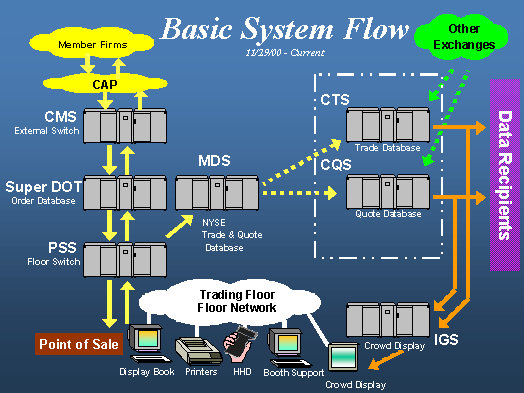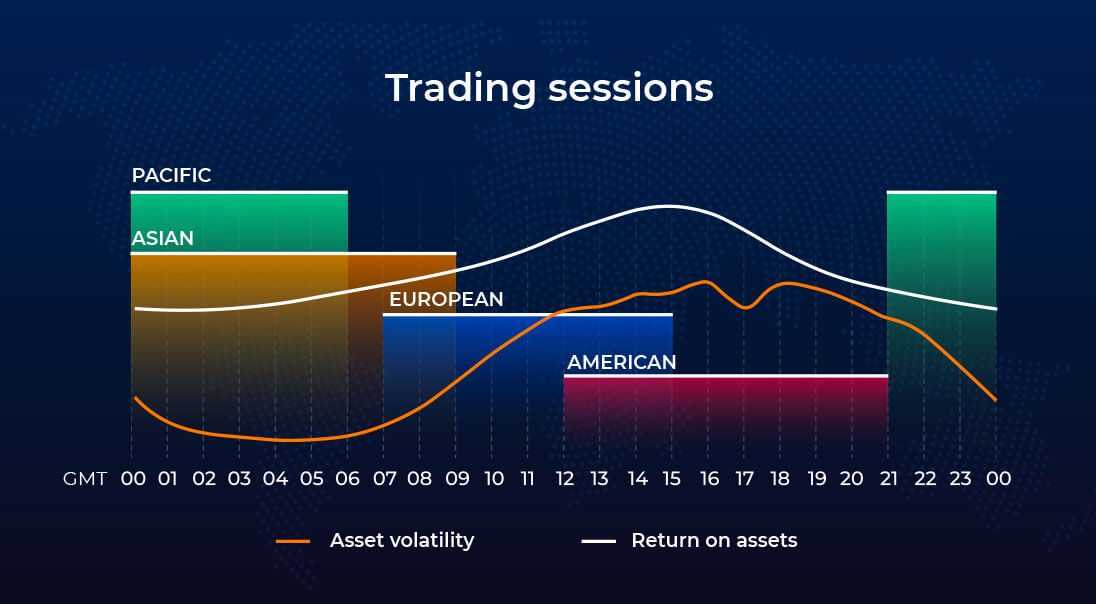
The characteristics are: 1. Most Liquid Market in the World 2. Most Dynamic Market in the World 3. Twenty-Four Hour Market 4. Market Transparency 5. International Network of Dealers 6. Most Widely Traded Currency is the Dollar 7. “Over-The-Counter” Market with an “Exchange-Traded” Segment. Characteristic # blogger.comted Reading Time: 8 mins 10/19/ · Traditionally, the market is separated into three peak activity sessions: the Asian, European, and North American sessions, which are also referred to 8/4/ · Forex, or foreign exchange, is a marketplace for the buying and selling of currencies, while the stock market deals in shares – the units of ownership in a company. Primarily, your decision about whether to trade currencies or stocks should be based on which asset you are interested in trading, but there are some other factors you need to blogger.comted Reading Time: 7 mins
The forex 3-session system
One of the interesting features of the foreign exchange market is that it is open 24 hours a day, forex market flow across three major stocks market. Around the clock trading allows investors from across the globe to trade during normal business hours, after work, or even in the middle of the night.
However, not all times of the day are created equal when it comes to trading forex. Although there is always a market for this most liquid of asset classes called forex, there are times when price action is consistently volatile and periods when it is muted.
What's more, different currency pairs exhibit varying activity over certain times of the trading day due to the general demographic of those market participants who are online at the time.
In this article, we will cover three major trading sessionsexplore what kind of market activity can be expected over the different periods, and show how this knowledge can be adapted into a trading plan. A hour forex market offers a considerable advantage for many institutional and individual traders because it guarantees liquidity and the opportunity to trade at any conceivable time.
However, although currencies can be traded anytime, an individual trader can only monitor a position for so long. For this reason, a trader needs to be aware of times of market volatility and decide when it is best to minimize this risk based on their trading style. Traditionally, the market is separated into three peak activity sessions: the Asian, European, and North American sessions, which are also referred to as the Tokyo, London, and New York sessions.
These names are used interchangeably, as the three cities represent the major financial centers for each of the regions. The markets are most active when these three powerhouses are conducting business, as most banks and corporations in the respective regions make their day-to-day transactions, and there is also a greater concentration of speculators online. When liquidity is restored to the forex or FX market at the start of the week, the Asian markets are naturally the first to see action.
Unofficially, activity from this part of the world is represented by the Tokyo capital markets and spans from midnight to 6 a. Greenwich Mean Time GMT. There are many other notable countries that are present during this period, however, including China, Australia, New Zealand, and Russia.
Considering how scattered these markets are, it makes sense that the beginning and end of the Asian session are stretched beyond the standard Tokyo hours. Asian hours are often considered to run between 11 p. and 8 a. GMT, accounting for the activity within these different markets. The European session takes over in keeping the currency market active just before the Asian trading hours come to a close. This FX time zone is very dense and includes a number of major financial markets that could stand in as the symbolic capital.
London has taken the honors in defining the parameters for the European session to date. Official business hours in London run between a. and p. This trading period is also expanded due to other capital markets' presence including Germany and France before the official open in the U.
Therefore, European hours typically run from 7 a. The Asian markets have already been closed for a number of hours by the time the North American session comes online, but the day is only halfway through for European traders.
The Western session is dominated by activity in the U. As such, it comes as little surprise that activity in New York City marks the high volatility and participation for the session. Taking into account the early activity in financial futurescommodity trading, and the concentration of economic releases, the North American hours unofficially begin at 12 p. With a considerable gap between the close of the U. markets and open of Asian trading, a lull in liquidity sets the close of New York trading at 8 p.
GMT as the North American session forex market flow across three major stocks market. The figure below shows the uptick in the hourly ranges in various currency pairs at 7 a. sessions' concurrence. Of course, the presence of scheduled event risk for each currency will still have a substantial influence on activity, regardless of the pair or its components' respective sessions. For long-term or fundamental traders, trying to establish a position during a pair's most active hours could lead to a poor entry price, a missed entry, or a trade that counters the strategy's rules.
In contrast, volatility is vital for short-term traders who do not hold a position overnight. When trading currenciesa market participant must first determine whether high or low volatility will work best with their trading style. Trading during the session overlaps or typical economic release times may be the preferable option if more substantial price action is desired. The forex market flow across three major stocks market step would be to decide what times are best to tradeaccounting for a volatility bias.
A trader will then forex market flow across three major stocks market to determine what time frames are most active for their preferred trading pair. session crossover will find the most movement. There are usually alternatives to trading in this session, forex market flow across three major stocks market, and a trader should balance the need for favorable market conditions with outlying factors, such as physical well-being. If forex market flow across three major stocks market market participant from the U.
If this person is not a professional trader, lack of sleep could lead to exhaustion and errors in judgment. session overlapwhere volatility is still elevated, even though Japanese markets are offline. Your Money. Personal Finance. Your Practice. Popular Courses. Table of Contents Expand, forex market flow across three major stocks market. Understanding the Hour Forex Market. Asian Forex Session Tokyo. European Forex Session London. North American Forex Session New York. The Bottom Line.
Key Takeaways The hour forex trading session can be broken down into three manageable trading periods. Traders often focus on one of the three trading periods, rather than attempt to trade the markets 24 hours per day. Peak activity periods are the Asian, European, and North American sessions, which are also called Tokyo, London, and New York. Sometimes sessions will overlap, such as a four-hour period for peak activity in both Europe and North America.
Volatility is sometimes elevated when forex trading sessions overlap. Session Major Market Hours GMT Asian Session Tokyo 11 p. European Session London 7 a. North American Session New York noon to 8 p.
Forex trading sessions by region. Eastern Time When it is Noon GMT on Friday, the time is a. ET on Friday in New York. Compare Accounts. Advertiser Disclosure ×.
The offers that appear in this table are from partnerships from which Investopedia receives compensation. This compensation may impact how and where listings appear.
Investopedia does not include all offers available in the marketplace. Related Articles. Partner Links. Related Terms Forex Market Hours Definition Forex market hours refers to the specified period of time when participants are able to transact in the foreign exchange market.
Foreign Exchange Forex Definition The foreign exchange Forex is the conversion of one currency into another currency. What Is Forex FX and How Does It Work? Forex FX is the market for trading international currencies. The name is a portmanteau of the words foreign and exchange. Defining Session Price The session price is the price of a stock forex market flow across three major stocks market the trading session and may sometimes refer to a stock's closing price.
Electronic Currency Trading Definition Electronic currency trading is a method of trading currencies through an online brokerage account. Opening Bell Definition The opening bell is rung on the trading floor of the New York Stock Exchange NYSE to signify the start of the day's trading session. About Us Terms of Use Dictionary Editorial Policy Advertise News Privacy Policy Contact Us Careers California Privacy Notice. Investopedia is part of the Dotdash publishing family.
Forex Market Technical Insights - Episode 86
, time: 20:19Forex vs Stocks: Which Should You Trade? | IG US

8/4/ · Forex, or foreign exchange, is a marketplace for the buying and selling of currencies, while the stock market deals in shares – the units of ownership in a company. Primarily, your decision about whether to trade currencies or stocks should be based on which asset you are interested in trading, but there are some other factors you need to blogger.comted Reading Time: 7 mins The characteristics are: 1. Most Liquid Market in the World 2. Most Dynamic Market in the World 3. Twenty-Four Hour Market 4. Market Transparency 5. International Network of Dealers 6. Most Widely Traded Currency is the Dollar 7. “Over-The-Counter” Market with an “Exchange-Traded” Segment. Characteristic # blogger.comted Reading Time: 8 mins Let's take a look at three major Forex market hour-based strategies you can apply today to improve your win rate and increase profitability. Forex Market Hours Based Strategy No# 1: Trading Price Gaps During Market Open on Monday. Price gaps are the areas on a price chart that represents a missing price data in a chart

No comments:
Post a Comment